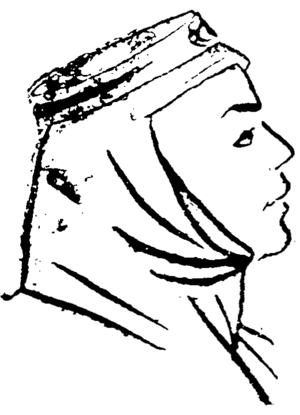Padishah Khatun facts for kids
Quick facts for kids Padishah Khatun |
|||||
|---|---|---|---|---|---|

a 1956 drawing of Padishah Khatun
|
|||||
| Ruler of Kirman | |||||
| Reign | 1292 – 1295 | ||||
| Predecessor | Suyurghatmish | ||||
| Successor | Kurdujin Khatun | ||||
| Born | 1256 Kerman |
||||
| Died | June 1295 (aged 38–39) Kushk Sar, Ilkhanate |
||||
| Burial | Gubba-i Sabz Mausoleum, Kerman | ||||
| Spouse | Abaqa Khan Gaykhatu |
||||
|
|||||
| Father | Qutb al-Din Mohammad | ||||
| Mother | Kutlugh Turkan | ||||
Padishah Khatun (born 1256, died 1295) was an important ruler of a region called Kirman. She ruled from 1292 to 1295. Padishah Khatun belonged to the Qutlugh-Khanid dynasty, a family that ruled parts of Persia (modern-day Iran) under the Mongol Empire. Her full name was Safwat al-Din Padishah Khatun.
Contents
Early Life and Family
Padishah Khatun was born in 1256. She was the youngest daughter of Qutb al-Din and Kutlugh Turkan. Her father passed away in 1257.
Even as a young woman, she had her own land. This land was in a place called Sirjan. Her mother, Kutlugh Turkan, helped her get this land. This happened after her mother visited the crowning ceremony of Abaqa in 1265.
Marriage to Abaqa Khan
Padishah Khatun's first marriage was to Abaqa Khan. They were married on May 22, 1272. Her mother arranged this marriage. It was a way to get support from the powerful Mongols for her family's rule.
After her marriage, Padishah Khatun was given the household of Abaqa's late mother. She played a big part in making her mother's rule stronger. She supported her mother against her own siblings. These siblings were Muzaffar al-Din Hajjaj and Suyurghatmish.
Life After Abaqa's Death
Abaqa Khan died in 1282. Padishah Khatun did not go back to Kerman right away. Instead, she stayed at the royal court. She lived with her mother until her mother passed away in 1283.
During her time at court, she sent her sister, Bibi Khatun, to Kerman. Bibi Khatun was there to look after Padishah's interests. Padishah gave her land in Sirjan to Bibi Khatun.
Seeking Power in Kerman
In 1284, Padishah Khatun gained influence with Arghun. This allowed her to co-rule Kerman. However, a powerful official named Buqa made a different decision. He supported her half-brother, Suyurghatmish.
Buqa quickly arranged for Padishah Khatun to marry Gaykhatu. Then, he sent her away to Anatolia in 1286. But Padishah Khatun did not give up. In 1289, she got her land in Sirjan back from Arghun.
Reign as Ruler
When Gaykhatu became the ruler in 1291, Padishah Khatun gained power again. She asked her husband to give her the rule of Kirman. She wanted it as her own personal territory. Her husband agreed to her request.
In October 1292, she had her half-brother, Suyurghatmish, put in prison. He managed to escape with help from his wife, Kurdujin Khatun. But he was soon captured and imprisoned again. Suyurghatmish was eventually killed on August 21, 1294.
Padishah Khatun was then given control of Yazd and Shabankara. She even got involved in the politics of Ormus. She replaced the prince, Rukn al-Din Masud, with Sayf al-Din Ayaz.
Death
Her husband, Gaykhatu, was killed on March 21, 1295. This put Padishah Khatun in a very difficult situation. She was immediately imprisoned. This order came from Kurdujin Khatun and Shah Alam. They were Suyurghatmish's widow and daughter.
Padishah Khatun was killed in June or July of 1295. This happened while she was on her way to Baydu's court in Kushk-e Zar. She was buried in the Gubba-i Sabz Mausoleum. This was the same place where her mother was buried.
Legacy and Achievements
Padishah Khatun was mentioned in the travel diary of Marco Polo. He was a traveler from Venice and lived at the same time as Padishah. Marco Polo described her as “an ambitious and clever woman, who put her own brother Siyurgutmish to death as a rival.”
She had both silver and gold coins made with her name on them. She also wrote several poems. She used the pen names Lala Khatun and Hasanshah. In one of her poems, she described herself as "the child of a mighty Sultan and the fruit of the garden that is the heart of the Turks". Padishah Khatun was also very skilled at calligraphy, which is beautiful handwriting.

